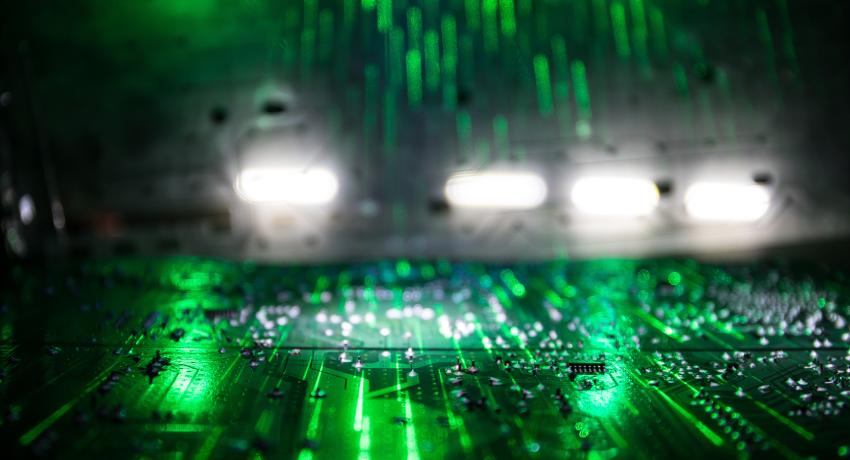"The type of question that we are facing is not ‘can it be done,' but how do you scale it up? That is the challenge we must solve.” - Giebink said. Credit: Adobe Stock
By Jamie Oberdick
Many people think of semiconductors as vital for computers, but they have another characteristic that makes them valuable: the ability to efficiently absorb and emit light.
This property of semiconductors enables high-efficiency LED lighting, which in turn makes them a valuable tool for reducing energy use. One of the Penn State researchers shining a light on this side of semiconductors is Chris Giebink, professor of electrical engineering. In his Applied Optoelectronics and Photonics Lab, Giebink leads a team exploring the intersection of optics and electronics.
“We do research in optoelectronic devices, which essentially means semiconductor devices that involve light and electrons,” Giebink said. “So, the most common manifestations of that end up being things like light-emitting diodes, which take an electrical current and output light, or solar cells, which take input light and generate electrical power. We do a lot of work with both of those.”
Traditionally, most semiconductor work was done with inorganic or “hard” semiconductors such as silicon and III-V materials. However, the work that Giebink does deals mainly with organic semiconductors, which are made up of small molecules or polymers.
“Most inorganic semiconductor folks would call these materials insulators,” Giebink said. “But nonetheless, they're very good from an optoelectronic standpoint in terms of being able to emit light efficiently.”
They have a variety of advantages over their inorganic counterparts. They are flexible and their emission wavelength (i.e., color of light) is easy to tune throughout the visible spectrum. Given their ease of fabrication, they are potentially cheaper to produce over a large area, and in some cases could even be printed via common printing systems.
Increasing the efficiency and lifetime of organic LEDs is key to Giebink’s research and is the focus of several of his lab’s projects. Organic light-emitting diodes have a variety of potential applications, such as more efficient solid-state lighting or uses in defense.
“We are working on using integrated LED-photovoltaic stacks for optoelectronic upconversion,” Giebink said. “For example, taking infrared light that is plentiful at night and upconverting it so it can be projected in the visible spectrum where you can see it, with the goal of making lighter, more compact night vision equipment.”
Giebink is also conducting research into organic and hybrid perovskite semiconductor lasers, especially the creation of a solution-processed laser diode. Currently, laser diodes are only made with hard semiconductors.
“This would open up a whole bunch of different potential applications for us to explore, because these types of laser diodes can be integrated with a wider range of materials and environments,” Giebink said. “Such as on silicon, glass, or soft polymeric materials that interface with stuff like skin, for example, situations where it's more difficult to work with epitaxial inorganic semiconductors.”
As a researcher, Giebink's work helps to enable a future where organic semiconductors are common. As an educator, he not only teaches his undergraduate students the fundamentals of semiconductors but also works to build enthusiasm in them for a career in semiconductors.
“Education is one of the major goals of the CHIPS Act,” Giebink said. “So, in the courses that I teach and the labs that I am involved with, in terms of educating undergraduates, what I do reflects the question of ‘how do we connect better with students about semiconductors and the industry?’ And ‘how do we get more people excited about that area of coursework?’”
These students may someday work on improving not just the semiconductors themselves but also improving their manufacturing. Giebink gave an example of manufacturing solar cells for use in space such as on satellites, and a technique that could enable the manufacture of these solar cells at a much lower cost.
“We take existing wafers that are already grown and divide them up into a zillion tiny little cells as small as a grain of sand,” Giebink said.
The next step is to pick each of them up and transfer them onto a piece of glass to form an array, then wire them together, and finally place a thin lens layer on top. Light is concentrated on each of these small cells, which enables a significant reduction in cost because it takes a much less expensive semiconductor to generate power over a given area.
"We’ve demonstrated small-scale proof-of-concepts, but it’s a major processing and fabrication challenge to scale up to large areas,” Giebink said. “We want to bring it up to the point where you can do it reliably at a much larger scale to equip the thousands of satellites that will be launching in the next few years. The type of question that we are facing is not ‘can it be done,' but how do you scale it up? That is the challenge we must solve.”
This article originally appeared in the Fall 2022 issue of Focus on Materials.

